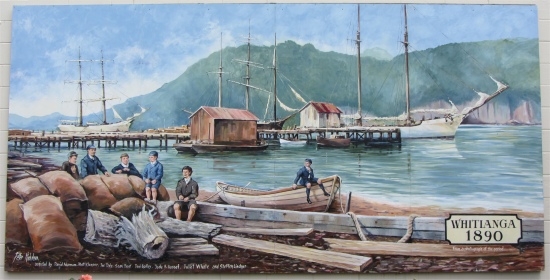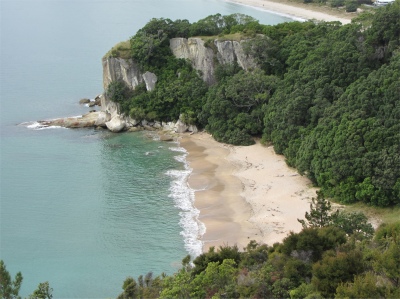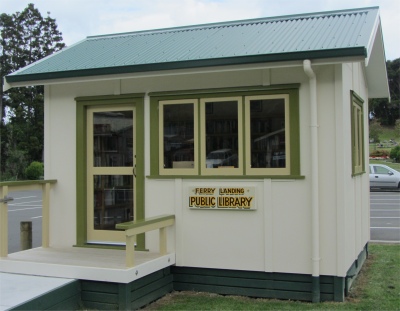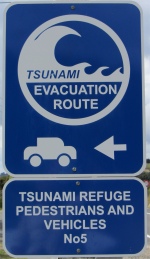I carried on to the end of the road, Ferry Landing, where there were just a cafe, a couple of shops, a library, and the foot passenger ferry jetty. Blink and you might miss it.
Across the Whitianga Harbour, just 100m away across on the ferry lay Whitianga. However, it took me a good 45 minutes to drive there around the long estuary, in a ferocious rainstorm. Whitianga serves as a tourist gateway for boat trips out around Mercury Bay and across to the sights I had seen further down the coast yesterday.
Like most small towns, it had its own historical tale to tell. In 1881, the original township of Whitianga began to relocate from the Ferry Landing side of the estuary to the flatter, western side of the river. Since then the town has grown steadily, servicing the farming, fishing and tourism industries that have grown up in and around Mercury Bay. By 1920 there were around 37 commercial and civic buildings in the Whitianga CBD; by 2011 the number had risen to over 200.
Originally paved with white shell from the beach, Albert Street, where I picked up a campsite, was first known as Coromandel Road. Later, when the town was fully surveyed by the Coromandel Council 1885, it was recorded as Back Road. Presumably the esplanade that follows the shore was the "Front Road". The present street name is derived from England's Prince Consort at the time - Prince Albert.
Albert Street seems to have seen some active times. Here follows an amusing account by a Walter Russell:-
"Sale Day was a monthly event. Farmers would drive their stock along Buffalo Beach then up the main street to the sale yards at the southern end of Albert Street. Most days they would pass through without much trouble but on some occasions it was sheer mayhem.
The town dogs had their own patches on the street and on some days would take offence at the country dogs barking in their patch; all hell would break loose. The shop keepers would take bets on which dog would win the scrap. While this was going on the cattle would scatter over fences, through the park, and into any open door way.
We had a steer come in our front door and out the back, followed by a horse and rider who yelled out, "Can you give me a grease and oil change?" My father had a bag of chaff in the corner we used to soak up oil. He said, "No, but I can give your horse lunch".
This would happen one or two times a day in the morning and again in the afternoon on the way home."

Whitianga Mural
|
When the town migrated across the river in 1881, the more space available allowed a large timber processing mill to be built here by the Kauri Timber Company. The mill and yards operated over 20 acres of land within Whitianga until 1922 when large scale kauri saw-milling ceased in the area.
The Mercury Bay Mill had operated successfully, but was moved to Great Barrier Island. On its final day of operation, with a full head of steam to drive it, the cord was tied down on the whistle. Its clear, full tones echoed up the valleys and over hills for over an hour, being heard as far as 16 miles away, marking the passing of an industry that was the foundation of modern Mercury Bay.
Whitianga was once the busiest export port in New Zealand, with ships from around the world calling to load kauri. Over 500 million cubic feet of wood were exported from here between 1882 up until the 1920s, when the economic focus moved to farming.
I came across an account on growing up in Whitianga:-
"There were always things to do or see at the wharf. We'd watch the Coaster "Lady Jocelyn" unloading, then take on butter and crayfish for Auckland. The Navy boats came and went, sometimes up to four or five at a time, the excitement of seeing the guns always made our day.
I guess the main thing was fishing, food on the table and the thrill of the catch. I remember well one day we were trying to catch some kingfish to no avail ... two pig hunters who were going to Back Bay hunting came along and said "step aside boys" and with a couple of quick shots with a 303 sorted out our kingfish, and we were then able to jump in and grab them. I don't think you would get away with it these days."
In 1934 the Art Deco building, that is now the museum, was built as a dairy. The Mercury Bay Co-Operative Dairy Company won many awards for its excellent butter, and it remained in operation until 1972.
Now, it was the base for an excellent small museum. The local historical society had produced an excellent 30 minute DVD about the history of the bay and Kupe's and Cook's landings. I had a chat with the curators, including a bloke in his 70s who was fifth generation Kiwi. His ancestors came from Devon. His job in times gone by involved travelling the globe, dragging his family with him. As a consequence his children are now scattered all over the world. He travels often to visit them, usually visiting the UK every 18 months on his rounds.
I drove out along the esplanade and pulled off the road to admire the view across the bay. A middle-aged couple were drying themselves on the embankment as I climbed up it. "How's it going?" I asked in the usual Kiwi greeting. "The sea is lovely, you must try it. I swim here every day," said the woman. "Even in winter?" I asked, staggered by that statement. "No, only in summer," she replied, and the couple both laughed, an infectious laugh.
They too were holidaying here, and like dozens of Kiwis I have met, complained about the poor summer they were experiencing. Normally summers are fairly hot, and all the grass turns straw coloured. However, wherever we looked, all was green.
And as all Kiwis do, they asked me about my travels, and then my family, and we got on to looking at my family photos. They were genuinely interested and were an ever so friendly couple. New Zealanders have time for each other.
We parted company as the rain clouds gathered, and it didn't take the rain long to settle in for the night.







